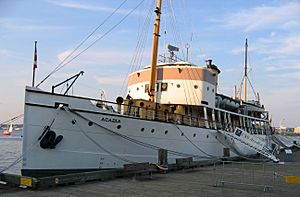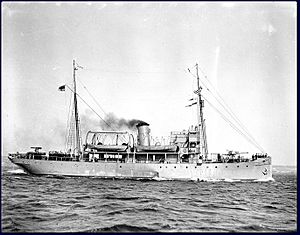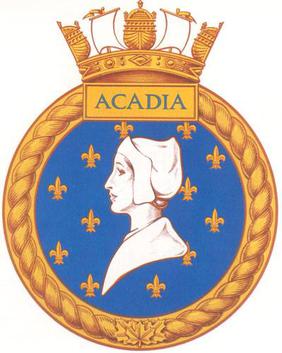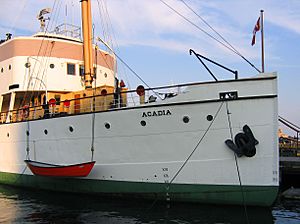CSS Acadia facts for kids

CSS Acadia preserved as a museum ship alongside the wharves of the Maritime Museum of the Atlantic in Halifax, Nova Scotia in 2007
|
|
Quick facts for kids History |
|
|---|---|
| Name | Acadia |
| Port of registry | Ottawa |
| Builder | Swan, Hunter & Wigham Richardson, Newcastle |
| Yard number | 912 |
| Laid down | 1912 |
| Launched | May 8, 1913 |
| Commissioned | as HMCS Acadia January 16, 1917; October 2, 1939 |
| Decommissioned | March 1919, November 3, 1945 |
| In service | September 1913 – November 1969 |
| Refit | New Bridge, Pictou, Nova Scotia, 1956 |
| Homeport |
|
| Identification | |
| Status | Museum ship, Halifax, 1982 |
| General characteristics | |
| Type | Hydrographic research ship/auxiliary patrol vessel |
| Tonnage | 846 GRT, 439 NRT |
| Displacement | 1,050 long tons (1,067 t) |
| Length | 181 ft 9 in (55.4 m) |
| Beam | 33.5 ft (10.2 m) |
| Draught | 19 ft (5.8 m) |
| Ice class | Ice strengthened |
| Installed power | 1,715 hp (1,279 kW) |
| Propulsion | Single shaft, 2 fire tube Scotch boilers, 1 triple expansion steam engine, |
| Speed | 12.5 knots (23.2 km/h) |
| Boats & landing craft carried |
4 survey launches, 2 lifeboats, 2 dories |
| Complement | 50 |
| Armament |
|
| Official name: S.S. Acadia National Historic Site of Canada | |
| Designated: | 1976 |
The CSS Acadia is a special ship from Canada's past. It was a survey and research ship for the Canadian Hydrographic Service. This means it helped map the ocean floor and coastlines.
Acadia worked for Canada for 56 years, from 1913 to 1969. It mapped almost all of Eastern Canada's coast. It even did important early surveys in Hudson Bay. This ship also served in the Royal Canadian Navy (RCN) twice as HMCS Acadia. It's the only ship still floating that was part of the RCN in both World Wars.
Acadia is also the last ship still afloat that was present during the 1917 Halifax Explosion. Today, it's a museum ship and a National Historic Site of Canada. You can visit it in Halifax Harbour at the Maritime Museum of the Atlantic.
Contents
Exploring the Acadia's Journey
The Acadia was designed in Ottawa by R.L. Newman, a Canadian naval architect. It was built in England by Swan Hunter & Wigham Richardson. The ship was named after Acadia, an old name for Atlantic Canada. It was launched on May 8, 1913.
Acadia arrived in Halifax on July 8, 1913. It started its first trip that same July. Its first name was CGS Acadia, which meant "Canadian Government Ship." Before 1917, it mapped Canada's Atlantic coast. This included checking tides and measuring ocean depths in many ports.
Early Mapping Adventures
For its first two years, Acadia mapped Hudson Bay. This helped open the way for a grain port in Port Nelson. In its first year, it also made the first Canadian maps of Sable Island. This island is known for being tricky to navigate.
Acadia also rescued the crew of the steamship Alette. That ship was stuck and crushed by ice in Hudson Bay. This was one of many rescue missions Acadia would do. One of its longest jobs was mapping the Bay of Fundy. This happened before it joined the military for World War I.
Acadia in World War I
When World War I started in 1914, Acadia helped patrol the Bay of Fundy. It sailed between Yarmouth, Nova Scotia and Grand Manan. On January 16, 1917, CGS Acadia joined the Royal Canadian Navy. It became HMCS Acadia and was used as a patrol ship.
The ship was armed with a 4-inch (102 mm) gun at the front. From 1917 to March 1919, it searched for enemy submarines. It patrolled from the Bay of Fundy along Nova Scotia's Atlantic coast. It also patrolled through the Gulf of Saint Lawrence.
On December 6, 1917, HMCS Acadia survived the Halifax Explosion. It was guarding the entrance to Bedford Basin. Luckily, it only had minor damage. Near the end of the war, it was used for experiments with anti-submarine balloons.
Between the World Wars
After World War I ended, HMCS Acadia went back to its original job. It returned to the Hydrographic Survey of Canada. This group was renamed the Canadian Hydrographic Service in 1928. The ship became CGS Acadia again.
It continued its mapping work through the 1920s and 1930s. In 1926, it became the first Canadian research ship to get an echo sounder. This device uses sound to measure water depth. A big success was mapping the area to create the port of Churchill, Manitoba.
Acadia also did important early oceanographic research for Canada. In 1929, Acadia rescued the crew of a crashed Sikorsky plane. The plane was trying to fly to Europe across Greenland and Iceland.
Acadia in World War II
CGS Acadia joined the Royal Canadian Navy again in October 1939. It became HMCS Acadia once more. First, it was used as a training ship for HMCS Stadacona in Halifax.
From May 1940 to March 1941, it patrolled the entrance of Halifax Harbour. It helped protect small groups of ships (convoys) entering and leaving the port. After some repairs, HMCS Acadia became an anti-aircraft training ship in mid-1941. It helped train crews for merchant ships that carried guns.
In June 1944, HMCS Acadia moved to the training base HMCS Cornwallis. It was used for gunnery training for new recruits and advanced training for officers. The name HMCS Acadia is still used today for a Sea Cadet summer training camp.
Later Years and Retirement
When World War II ended, HMCS Acadia left the navy on November 3, 1945. It went back to the Canadian Hydrographic Service. Its new name was CSS Acadia, which stood for Canadian Survey Ship.
After the war, a big job was updating maps of Newfoundland and Labrador. This happened after the province joined Canada in 1949. In 1962, Acadia rescued hundreds of people from forest fires in Newfoundland. It helped evacuate two towns.
Acadia also helped with military mapping for the Royal Navy, Royal Canadian Navy, and United States Navy. By the end of its career, Acadia had mapped almost every part of Atlantic Canada and much of the Eastern Arctic.
Becoming a Museum Ship
Acadia stopped active service on November 28, 1969. It was then given to the Bedford Institute of Oceanography (BIO) to become a museum ship. In 1976, Acadia was named a National Historic Site.
On February 9, 1982, the BIO gave CSS Acadia to the Maritime Museum of the Atlantic. This was to make sure it would be kept safe and shared with visitors. It is docked at the museum's North Wharf and is open to visitors from May to October.
Acadia is known for being one of the last ships in Halifax to have an official ship's cat. These cats helped control rodents. Every five years, Acadia goes into dry dock for maintenance. This helps keep its hull in good condition.
In the summer, HMCS Sackville joins Acadia at the museum wharves. Sackville is a warship that sometimes did mapping. Acadia is a mapping ship that sometimes became a warship. They show an interesting contrast.
Acadia is the only known ship still floating that survived the Halifax Explosion in 1917. Every year on December 6, the anniversary of the explosion, Acadia flies the same signal flags it flew that day.
Acadia's Film Roles
Acadia has been used in many films to pretend to be other ships. Here are some examples:
- A Japanese destroyer in the 1982 film South Pacific '42.
- A Scottish immigrant ship in the 1990 film The Little Kidnappers.
- SS Mont-Blanc in the 1992 Halifax Explosion film Morning of Armageddon.
- A World War II merchant ship in the 1992 TV show Lifeline to Victory.
- RMS Lusitania in the 1996 docudrama Lusitania.
- The ocean liner RMS Republic in the 1996 PBS show Rescue at Sea.
- A hospital ship in the 1998 short film Halifax 1917.
- A 19th-century ocean liner in Alexander Keith's Brewery beer commercials in 2000.
- HMS Beagle in a 2009 NOVA/National Geographic docudrama Darwin's Darkest Hour.
- A San Francisco ferry and steam-powered sealing ship in the 2009 miniseries Sea Wolf.
- Both RMS Titanic and the cable ship CS Mackay-Bennett in the 2011 docudrama Waking the Titanic.
Meet the Acadia's Crew
Most of Acadia's crew came from the Eastern Shore of Nova Scotia. Many worked on the ship for their whole careers. This shows it was a "happy ship" where people enjoyed working. Many of its officers were from Newfoundland.
When it was a mapping ship, the Hydrographer in Charge was the main officer. They decided where Acadia would go and what it would do. At the same time, the Captain managed the ship's daily tasks. During wartime, naval officers took over.
Erik the Red, the Ship's Cat
Named after the famous Viking, Erik the Red was a tabby cat. He was born around 1997. Erik served on Acadia as the rodent control officer. People believe he was a stray cat who snuck onto the ship on Canada Day in 2000.
He first worked with another cat named Clara. After Clara retired, Erik took over the job. Erik the Red survived three times when he went missing or was taken. This worried people because Erik needed daily medicine to eat.
Erik became a well-known local attraction on the boardwalk. He was welcomed in stores along the waterfront. Erik retired in 2015 during a party held for him. He passed away in July 2017 after a short illness.
Images for kids
See also
- List of museum ships
- Ships preserved in museums







